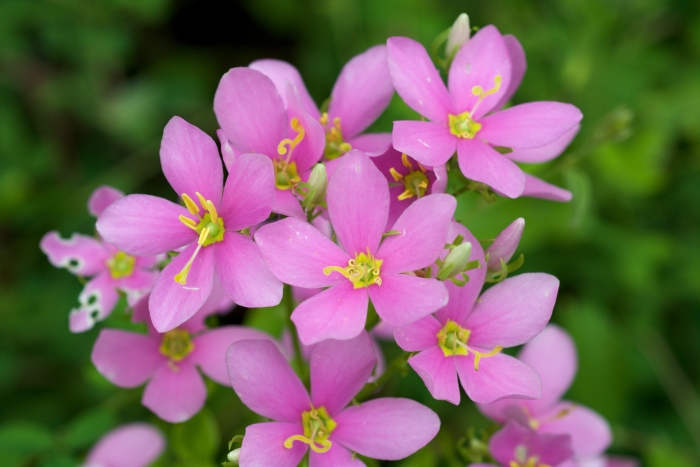Rosepink
(Sabatia angularis)
Rosepink (Sabatia angularis)
/
/

Eric Hunt
CC BY-SA 4.0
Image By:
Eric Hunt
Recorded By:
Copyright:
CC BY-SA 4.0
Copyright Notice:
Photo by: Eric Hunt | License Type: CC BY-SA 4.0 | License URL: https://creativecommons.org/licenses/by-sa/4.0 | Uploader: Eric in SF | Publisher: Wikimedia Commons | Title: Sabatia_angularis_3.jpg | Notes: |




















































Estimated Native Range
Summary
Sabatia angularis, commonly known as Rosepink, is an annual herb native to moist meadows, prairies, and open woodlands in Eastern North America. It typically grows to a height of 1-3 feet (0.3-0.9 meters) and a width of 1-2 feet (0.3-0.6 meters). Rosepink features a square stem and opposite leaves, with showy star-shaped flowers that are pink with a greenish-yellow center, blooming from mid-summer to early fall. The flowers are quite attractive to butterflies and other pollinators.
Rosepink is valued for its delicate, vibrant flowers and is used in wildflower gardens, meadow plantings, and as a border plant. It is relatively low-maintenance, requiring medium amounts of water and thriving in full sun to part shade. It prefers moist, well-drained soils but can adapt to various soil conditions. While not commonly found in cultivation, it can be a charming addition to native plant gardens. Potential problems include susceptibility to root rot in overly wet conditions and competition from more aggressive plants. Rosepink is not known to be invasive and does not have aggressive roots, making it a safe choice for most garden settings.CC BY-SA 4.0
Rosepink is valued for its delicate, vibrant flowers and is used in wildflower gardens, meadow plantings, and as a border plant. It is relatively low-maintenance, requiring medium amounts of water and thriving in full sun to part shade. It prefers moist, well-drained soils but can adapt to various soil conditions. While not commonly found in cultivation, it can be a charming addition to native plant gardens. Potential problems include susceptibility to root rot in overly wet conditions and competition from more aggressive plants. Rosepink is not known to be invasive and does not have aggressive roots, making it a safe choice for most garden settings.CC BY-SA 4.0
Plant Description
- Plant Type: Herb
- Height: 1-3 feet
- Width: 1-2 feet
- Growth Rate: Moderate
- Flower Color: Pink
- Flowering Season: Summer, Fall
- Leaf Retention:
Growth Requirements
- Sun: Full Sun, Part Shade
- Water: Medium
- Drainage: Slow, Medium, Fast
Common Uses
Butterfly Garden, Fragrant, Low Maintenance, Showy Flowers, Water Garden
Natural Habitat
Moist meadows, prairies, and open woodlands
Other Names
Common Names: Rose-Pink, Common Rose-Pink, Bitterbloom, Squarestem Rosegentian
Scientific Names: , Sabatia angularis, Chironia angularis, Sabatia angularis f. albiflora, Sabatia angularis var. albiflora, Chironia angularis var. latifolia, Sabatia angularis f. angularis,
GBIF Accepted Name: Sabatia angularis (L.) Pursh